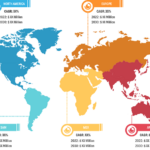New configuration requirements such as the WELL Building Standard and the Wired Certification Guidelines are expected to positively impact the HVAC system designs in the future, which can fuel the growth of the market globally. Despite the fact that there is no national energy code or standard in the US, reference standards for commercial building energy efficiency, such as ASHRAE, provide minimum equipment efficiency and design requirements for HVAC systems, which are substantial contributors to greenhouse gas (GHG) emissions. Therefore, the development of new HVAC configuration standards is anticipated to result in cost-effective and energy-efficient enhancements, which is further expected to drive the building automation system market growth.
The state governments are putting low-carbon architecture at the forefront of their climate impact targets as the public and private sectors become aware of the detrimental effects of GHG emissions by commercial buildings, which is expected to surge the demand for building automation systems. Moreover, to cater to this, the New York City Council passed Local Law 97, a bold proposal to cut carbon emissions from buildings by 40% by 2030. Such climate impact goals are expected to encourage future advances in building automation systems, both for new HVAC systems and those that must be updated to meet carbon emission restrictions, propelling the growth of the building automation system market.

China Holds the Largest CAGR in Asia Pacific Building Automation System Market
The building automation system market in China is expected to grow significantly owing to the rise in technological adoption, rapid urbanization, increased spending of consumers on security and surveillance, and huge growth in the construction industry. China is the world’s largest construction market and has played an increasingly important role in bolstering the country’s economy. For instance, China’s building construction completion value totaled US$ 1.25 trillion (CNY 7.94 trillion) in 2021. Residential construction accounted for 63% of the total building construction. The rest was mostly office buildings and factories. The share of local government funding to infrastructure construction activity rose to 39% in 2022 from 18% in 2021. According to Design Build Network, investment in infrastructure increased by 7.4% between January and July 2022. In September 2022, China issued US$ 29 billion in special loans to help developers finish stalled housing projects. China’s urbanization rate is the highest in the world. According to the American Institute of Architects (AIA) Shanghai report, China is expected to construct the equivalent of 10 New York-sized cities by 2025. Thus, the growing construction market is expected to fuel the building automation system market growth in the country during the forecast period.
Segmental Overview
Based on component, the building automation system market is bifurcated into hardware and software and services. The hardware segment held the largest building automation system market share in 2022, whereas the software and services segment is anticipated to register the highest CAGR during 2022–2030. The hardware segment is further bifurcated into security and surveillance systems, facility management systems, fire protection systems, and others. The security and surveillance system segment held the largest building automation system market share in 2022, and the facility management systems segment is anticipated to register the highest CAGR during 2022–2030. By end user, the building automation system market is categorized into commercial, industrial, and residential. The commercial segment held the largest share in the building automation system market in 2022 and is anticipated to register the highest CAGR during 2022–2030.
Building Automation System Market Analysis: Competitive Landscape and Key Developments
ABB Ltd, Mitsubishi Electric Corporation, Robert Bosch GmbH, Honeywell International Inc, Schneider Electric, Siemens AG, Johnson Controls International, Carrier, Lutron Electronics Co Inc, and Trane Technologies are among the key building automation system market players profiled in the report. Several other essential building automation system market players were also analyzed for a holistic view of the market and its ecosystem. The report provides detailed market insights to help major players strategize their growth.
- In August 2023, Carrier released the i-Vu Express building automation device. The new connected device comes pre-installed with i-Vu Express v8.5 software and can receive automatic software updates. Packed with features, the i-Vu Express building automation system provides a 360-degree view of a building’s entire operation, allowing operators to maintain comfort for occupants, optimize energy usage, and resolve problems faster.
- In March 2023, Siemens Smart Infrastructure launched Connect Box, an open and easy-to-use IoT solution designed to manage small to medium-sized buildings. This Connect Box is a user-friendly approach for monitoring building performance, with the potential to optimize energy efficiency by up to 30% and to substantially improve indoor air quality in small to medium-sized buildings such as schools, retail shops, apartments, or small offices. Also, Connect Box allows users to accomplish essential daily building management tasks from one place via a cloud-based interface with no additional gateway or software.
- In January 2023, ABB launched its ABB Cylon Smart Building Management Systems (BMS) for the Middle East at the Light Middle East and Intelligent Building Middle East 2023 event. The ABB Cylon Smart Building Management Systems portfolio of products covers scalable automation and energy control for a wide variety of commercial or industrial buildings, regardless of size. The BMS enables buildings to automate functions and reduce energy costs with energy control and management. It also allows real-time monitoring and control of the building facility.








